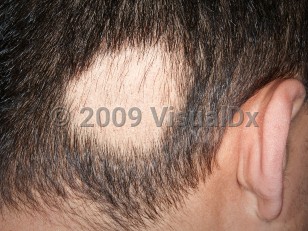Alopecia areata in Child
See also in: External and Internal Eye,Hair and Scalp,Nail and Distal DigitAlerts and Notices
Important News & Links
Synopsis

Alopecia areata is seen equally in both sexes and in patients of all ages and races / ethnicities; however, it is most commonly seen in patients between the ages of 5 and 40 years. There is an increased incidence of alopecia areata in patients with Down syndrome as well as those with autoimmune diseases, most commonly thyroid disease. In addition, there may be a family history of alopecia areata or autoimmune disease. Patients with alopecia areata are also more likely to have atopy, and its presence is felt to be a poor prognostic indicator. Alopecia areata following COVID-19 infection and COVID-19 vaccination has also been reported.
The course of alopecia areata is unpredictable, with wide variation in duration and extent of disease occurring from patient to patient. In most patients, hair will eventually spontaneously regrow, although recurrences are common. The condition is treatable but cannot be cured.
Codes
L63.9 – Alopecia areata, unspecified
SNOMEDCT:
68225006 – Alopecia areata
Look For
Subscription Required
Diagnostic Pearls
Subscription Required
Differential Diagnosis & Pitfalls

Subscription Required
Best Tests
Subscription Required
Management Pearls
Subscription Required
Therapy
Subscription Required
Drug Reaction Data
Subscription Required
References
Subscription Required
Last Updated:02/01/2024
 Patient Information for Alopecia areata in Child
Patient Information for Alopecia areata in Child- Improve treatment compliance
- Reduce after-hours questions
- Increase patient engagement and satisfaction
- Written in clear, easy-to-understand language. No confusing jargon.
- Available in English and Spanish
- Print out or email directly to your patient



